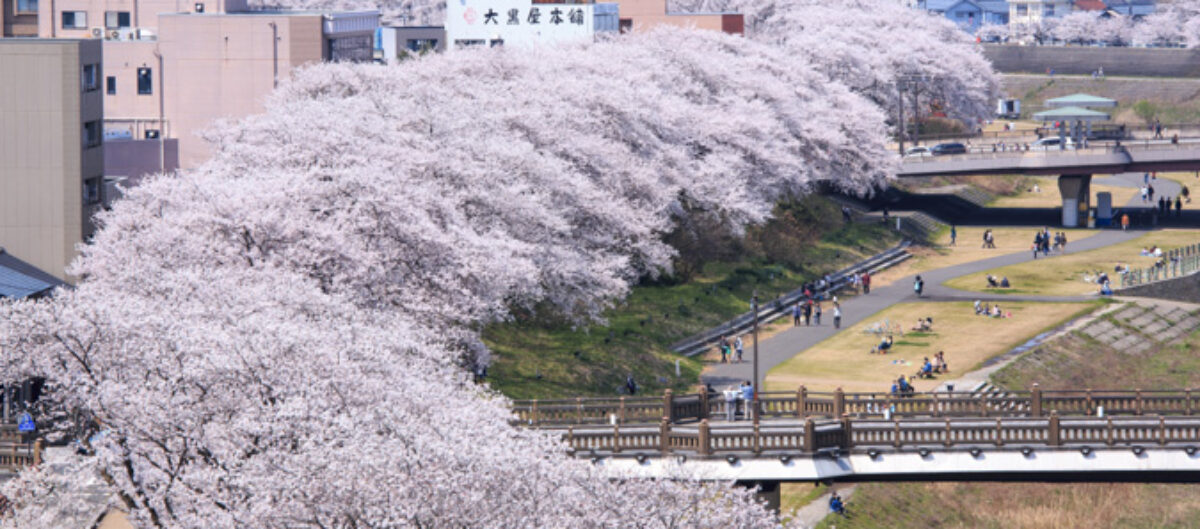


July/31/2019
Today, I watched some sumo matches in Echizen, Fukui Prefecture. Between the main sumo tournaments, sumo wrestlers go to rural towns and hold exhibition matches for a day at a time. It was the first time I’d ever watched sumo live.
Sumo is well known around the world, so you may know something about it. However, the history of sumo and the meanings of the sumo wrestlers’ motions aren’t as well known.
Sumo is one of the national sports of Japan, and it has a 1,500-year history. Sumo is a sport, but it’s also a religious ceremony to tell fortunes about good or bad harvests for the year.


For this reason, there are deep meanings behind sumo.
The sumo ring is a holy place where the gods come to earth.- Sumo wrestlers climb up onto the sumo ring from the east and the west. This represents the rising and setting sun.
- Sumo wrestlers’ squatting position, called sonkyo, represents their respect for both their opponent and the ring.
- Sumo wrestlers do foot-stamping called shiko to stamp out the devils in the ring.
- Sumo wrestlers throw salt towards the center of the ring. This represents purifications of the ring and both wrestlers. It’s also meant as a prayer for the safety of both wrestlers.
There are two basic rules of sumo.
- If any part of your body except the sole of your foot touches the ring, you lose.
- If any part of your body touches the outside of the ring, you lose.
I think that an interesting, unique point is that sumo doesn’t have weight classifications. Most of the one-on-one sports like wrestling, judo, and boxing have weight classifications. However, in sumo, big wrestlers and small wrestlers fight in the same ring.
When you watch sumo, you may notice that sumo wrestlers don’t show any joy when they win. This is because sumo is strongly influenced by Bushido, which is the moral code of the samurai( Japanese
The official listing of rankings or banzuke is also an interesting system in sumo. Sumo wrestlers are ranked in 10 stages. The top rank is called Yokozuna, and the second rank is called Ozeki. If the wrestlers win a lot, they can climb up to the high ranks.
The Yokozuna are required to act as role models for other sumo wrestlers. When they win using tricky movements, they’re often criticized.
The sumo event I attended went from 8 a.m. to 3 p.m. I went to the venue at 10 a.m.


I had a good view of the ring and the wrestlers from my seat. There was a large audience, including small children and elderly people, and eventually, about 2,700 people came to the venue. I was a little bit surprised to see a few foreign people, too.
In the ring, the wrestlers were practicing very hard. I looked out for my favorite sumo wrestler, and I found him quickly. Since his body is white, I noticed him straight away.

My favorite wrestler is the Yokozuna Hakuho, who’s a Mongolian and holds the record for the most titles in history.
I was curious about why he’s so strong, so I read his book. He wrote that he managed to become a Yokozuna for the following two reasons:
- He practiced Sumo correctly.
- He practiced a little bit harder than the others.
In my opinion, his father is a big factor, too. Hakuho’s father is a Yokozuna in Mongolian sumo and a national hero. In addition to that, his father won a silver medal in wrestling at the Mexico Olympics.

When Hakuho climbed up onto the sumo ring, the audience clapped very loudly. He practiced a lot with the other wrestlers, and I noticed that his body gradually turned red.

The sumo matches began at 11:30 a.m. First, the low-ranked wrestlers appeared.
When you watch sumo, you should pay attention to the start of the bout. It’s said that the essential point of sumo is the start of the bout. Almost all matches are determined by the start.

When I watched the bouts, I saw one really interesting match: Dewanojo vs Hokutoryu. Dewanojo weighs 192 kg, and Hokutoryu weighs 112 kg, so there’s an 80 kg difference between them.
I was curious about which would win.

I was surprised when Hokutoryu won by frontal force out.
There are referees in sumo, too, and they’re also ranked. The chief referees carry

Next, Hakuho put a heavy rope around his waist.

I felt that his standing posture was natural and beautiful.

There was one sumo wrestler who made the audience laugh called Enho. He’s 168 cm tall and weighs 99 kg. He’s one of the smaller sumo wrestlers. He showed some tricky techniques and the audience enjoyed watching his bout.

I noticed that he was smiling during the match.

Then, the final bout came: Yokozuna Hakuho vs Yokozuna Kakuryu. I’d been waiting for this bout for a long time. All the sumo fans, including me, were very excited.


At the last Grand Sumo Tournament in Nagoya, Kakuryu won the title by defeating Hakuho. Which of them would win this time?

Hakuho threw a lot of salt high into the air and received loud applause from his fans.

The bout began. They collided very strongly with each other. I was surprised by Hakuho’s quick movements. They locked squarely with each other. However, Hakuho held Kakuryu tighter. Kakuryu couldn’t move.


Hakuho pushed Kakuryu towards the outside of the ring. At last, Hakuho won by frontal force out.
If you have a favorite sumo wrestler, you can enjoy watching sumo. Feel the soul of Japan by watching sumo!
(If you want to watch sumo matches, visit the Sumo Kyokai’s official website. )
(References)
日本相撲協会公式サイト
「相撲見物」(著:伊藤勝治)(翻訳:デビッド・シャピロ)(青幻舎)
「大相撲の解剖図鑑」(監修:第34代木村庄之助・伊藤勝治)(エクスナレッジ)
「相撲よ!」(白鵬翔)(角川書店)
「力士の世界」(33代木村庄之助)(KADOKAWA/角川学芸出版)
「大相撲 行司さんのちょっといい話」(36代木村庄之助)(双葉社)
「福井新聞」(8月1日2019年)
